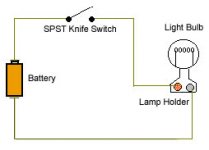How would I go about doing that? I'm a bit of a rookie when it comes to auto repair.
Here's a basic idea of how a circuit works:

Here's a video on how to use a test light:
https://www.youtube.com/watch?v=ksrsXwwukFc
Basically, any metal part of the frame or body is the ground circuit. So at the rear of your vehicle, you can hook the clip of the test light onto any body bolt as long as it has exposed metal and isn't protected by paint. Then anything you touch with the pointed end of the light and causes the light to light up, means there is power there. So carefully touch the inside of the socket where the power wire is, to see if there is indeed power there. Obviously the switch for the circuit needs to be closed, so if it's the brake circuit, you'll have to wedge something to keep the brake pedal down, etc. Be careful not to drag the edge of the test light needle on any other metals at the same time, or you will cause a direct short and blow a fuse.
Checking the GROUND circuit can be done by hooking the test light clamp on the POSITIVE terminal and then probing the GROUND metal with a pin, however, the light cord isn't that long, so checking in the rear of vehicle may require jumper cables, etc.
Or you could buy a DVOM with a continuity tester, I prefer those over a test light anyways.
If you haven't already, make sure fuses are good.

